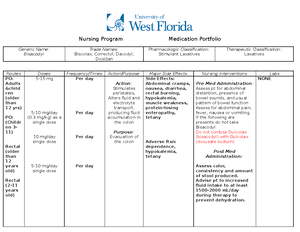- Information
- AI Chat
Was this document helpful?
Percocet - Drug Card
Course: Nursing Pharmacology (NUR )
71 Documents
Students shared 71 documents in this course
University: University of West Florida
Was this document helpful?

Nursing Program Medication Portfolio
Generic Name:
Oxycodone hydrochloride—
acetaminophen
Trade Names:
Percocet
Pharmacologic Classification:
Opioid agonists-para-aminophenol
derivatives
Therapeutic
Classification:
Opioid analgesic,
antipyretic
Routes Doses Frequency/Tim
es
Action/Purpo
se Major Side Effects Nursing
Interventions Labs
Oral
Solution
Tablets
Tablets
(extended
-release)
325 mg
acetaminophe
n and 5mg
oxycodone
5 mg oxycodone
hydrochloride and
300 mg
acetaminophen,
7.5 mg oxycodone
hydrochloride and
300 mg
acetaminophen, 10
mg oxycodone
hydrochloride and
300 mg
acetaminophen,
2.5 mg oxycodone
hydrochloride and
325 mg
acetaminophen, 5
mg oxycodone
hydrochloride and
325 mg
acetaminophen,
7.5 mg oxycodone
hydrochloride and
325 mg
acetaminophen, 10
mg oxycodone
hydrochloride and
325 mg
acetaminophen
Moderate pain:
Adults:
Oxycodone
2.5 to 10 mg
and
acetaminophe
n 325 mg P.O.
every 6 hours
as needed for
pain. Adjust
dosage based
on pain
severity and
patient
response.
Maximum daily
doses
shouldn’t
exceed 60 mg
oxycodone or
4 g
acetaminophe
n
Acute pain:
Action:
Oxycodone
binds with
opioid receptors
in the CNS,
altering
perception of
and emotional
response to
pain.
Acetaminophen
is thought to
produce
analgesia by
inhibiting
prostaglandin
and other
substances that
sensitize pain
receptors. The
combination
reduces pain
more
effectively than
acetaminophen
alone.
Purpose:
CNS: paresthesia,
hypoesthesia,
Dizziness, drowsiness,
fatigue,
headache, euphoria,
dysphoria,
insomnia.
CV: peripheral edema,
circulatory depression,
hypotension, shock.
EENT: dry mouth.
GI: constipation, dyspepsia,
nausea,
vomiting.
GU: dysuria.
Hematologic: thrombocytop
enia,
hemolytic anemia,
neutropenia, pancytopenia,
thrombocytopenia.
Respiratory: cough, apnea,
respiratory arrest,
respiratory depression.
Skin: pruritus, erythema,
erythematous dermatitis,
excoriation, rash, flushing.
Pre Med
Administration:
Asses current pain
level and last time
drug was
administered
Post Med
Administration:
Monitor
circulatory
and
respiratory
status
closely,
especially
within the
first 24 to
72 hours of
initiating
therapy.
Withhold
dose and
notify
-May increase
potassium,
amylase,
bilirubin, or liver
enzyme levels.
May increase or
decrease blood
glucose level.
-May decrease
platelet count.
-Oxycodone
may cause
cross-reactivity
with urinary
assays used to
detect cocaine
and marijuana.
-Quinolones
(levofloxacin,
ofloxacin) may
cause a false-
positive urine
screen result for
opioids.






